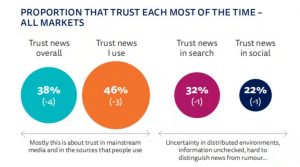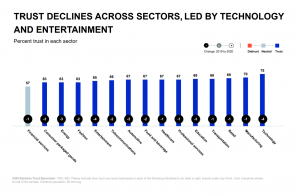
“Tech companies” by Huzaifa Abedeen, CC BY-SA 4.0 https://creativecommons.org/licenses/by-sa/4.0, via Wikimedia Commons
What is meant by the “techlash”?
Techlash is a term coined by the Economist and popularized in 2018. Advanced information technology is generally regarded as positive and advantageous because it provides more choices and convenience for people’s life (Atkinson, Brake, Castro, Conliff, Kennedy and McLaughlin, 2019). However, when people focus more on the negative impact and technological impact of digital technology, they will show an aversion to continuous technological innovation and support policies to curb it (Atkinson et al, 2019). These negative effects include threats to privacy on public platforms, the spread of misinformation and reduced face-to-face interactions (Hemphill, 2019). Techlash is hostile to big tech companies and platforms and to modern technology itself (Atkinson et al, 2019). It’s a growing social backlash related to the rise of digital technology, and widespread hostility and fear (Flew, 2018). Therefore, the public is also paying close attention to the problems caused by Techlash and worrying about its impact.
Public concerns that lie behind the techlash
The public attention and concern that lies behind techlash are not unreasonable. In his 2018 speech, the U.S. Chamber of Commerce President Donohue warned of a growing backlash against big tech companies and social media platforms, both at home and abroad and between governments and the public (Neidig, as cited in Hemphill, 2019). And public distrust is growing.

According to the report, the index of people’s trust in tech companies and social media platforms dropped from 53% in 2017 to 42% in 2018 (Atkinson et al, 2019). There are also concerns about government oversight of technology, with distrust rising from 40% in 2017 to 55% in 2018 (Atkinson et al, 2019). And in 2018, major social media companies like Facebook, Google and Twitter became the focus of techlash in the U.S. due to a number of social and economic issues that made people uneasy (Hemphill, 2019).

Trust declines across sectors, led by technology and entertainment. Source: Percent trust in each sector by Edelman Trust Barometer (2020)
The first is the social aspect. Due to some issues directly related to techlash, this has led to public distrust of social media platforms and news information. In 2016, Donald Trump was unexpectedly elected president of the United States, and his campaign team was suspected of manipulating the algorithms used to participate in political campaigns (Flew, 2018). Additionally, during the election, Russia allegedly created fake news websites in an attempt to disrupt people and increase their vote for Donald Trump (Hemphill, 2019). And it has sparked a debate about the use of misinformation and the manipulation of mainstream social media algorithms with fake news (Flew, 2018). The Revelations have led to a perceived loss of integrity in political campaigns and a loss of trust in government and social media. And now the tech leaders are also increasingly being asked by politicians to be more accountable in public (Hemphill, 2019).
There is also concern that some technology companies and online platforms are undermining consumers’ privacy and manipulating them. An example is, whistleblower Wylie who revealed to “The Guardian” that Facebook was using a number of unfair methods to obtain personal information and data from users, such as forcing users to take quizzes and illegally providing the data to third parties (Flew, 2018). Their ubiquitous data-gathering has sparked talk of “surveillance capitalism” (Atkinson et al, 2019). Parker, the former president of Facebook, has pointed out that one of the reasons for Facebook’s success in product development is that they exploit the psychology of users (Atkinson et al, 2019). This leads them to spend more time interacting with social media or unwittingly sharing their data and spending money. Digital platforms can employ algorithmic automation to maintain users’ attention, regardless of whether media content is trusted or whether data collection is voluntary or justified (Atkinson et al, 2019). For the public, this manipulation also threatens their privacy, and the “black box” focus on algorithmic content and data management is a crisis of confidence in social institutions (Flew, 2018, p26).
An investigation of consumer distrust in technology
Source: https://www.youtube.com/watch?v=r5xM06WSWBo
Moreover, critics of techlash argue that as techlash gains momentum and support for easing restrictions on innovation and platform development grow, regulation will become more stringent and restrictive (Atkinson et al, 2019). Technology shocks lead to technology bans, and may even lead to regulations with broader negative effects that reduce productivity, slow wage growth, and even limit consumer welfare (Information Technology and Innovation Foundation, 2019). The public is worried that this will further affect economic development and their economic interests.
The regulatory turn by governments, society organizations, and the technology companies themselves
Therefore, to regain the trust of platform users and the masses, the government, civil society organizations and technology companies themselves need to take necessary measures to solve these problems to a certain extent.
Government supervision is a traditional and effective way of restraint, and it is closely connected with the supervision of the platform itself (Gillespie, 2017). Gillespie (2017) proposes to involve policymakers and regulators directly, and to strengthen regulatory regimes for platforms and algorithmic programs. In mainland China, for example, the government has banned access to social media platforms such as Twitter and Facebook in order to strengthen regulation and avoid being influenced by the various social media platforms (Gillespie, 2017). Direct supervision can effectively protect users’ privacy and maintain network information security, and to some extent ensure the authenticity of the news and other media information. However, the disadvantage of government regulation is that the updating of regulatory policies is slower than technological innovation (Hemphill, 2019). Therefore, this is limited and the supervision method needs to be improved according to the actual situation.
The second is to adopt the form of supervision by social organizations. For example, the United States proposed a self-regulating organization to replace public supervision. This regulatory model requires an additional third party to act as a watchdog (Hemphill, 2019). It requires higher organizational transparency and accountability to ensure fairness for platforms and tech companies and safeguard the interests of stakeholders (Hemphill, 2019).
In addition, to deal with the techlash issue, tech companies need to consider the social impact of technologies and platforms before they enter the market (Hemphill, 2019). This self-regulatory approach takes into account the moral implications and helps to assuage public concerns to a greater extent.
According to the above analysis of techlash, the rapid development of digital technology has exerted varying degrees of influence on politics, economy and society. And the onslaught of technology has raised concerns about the way people access and trust information. Techlash is catching people’s attention. And governments, social organizations and technology companies are all looking for ways to ease people’s fears about new technology and distrust of the media. To cope with this new and complex environment, governments, technology companies and the public need to do more.
References
Atkinson, R. D., Brake, D., Castro, D., Cunliff, C., Kennedy, J., McLaughlin, M., & New, J. (2019). A policymaker’s guide to the “techlash”—what it is and why it’s a threat to growth and progress. Information Technology and Innovation Foundation.
https://itif.org/publications/2019/10/28/policymakers-guide-techlash
Bakardjieva, M. (2011). The Internet in Everyday Life: Exploring the Tenets and Contributions of Diverse Approaches. In The Handbook of Internet Studies (pp. 59–82). Wiley‐Blackwell. https://doi.org/10.1002/9781444314861.ch4
Flew, T. (2018). Platforms on trial. Intermedia, 46(2), 24-29.
Gillespie, T. (2017). Regulation of and by Platforms. In J. Burgess, A. E. Marwick & T. Poell (Ed.), The SAGE Handbook of Social Media (pp 254-273). London: SAGE Publications.
Hemphill, T. A. (2019). “Techlash”, responsible innovation, and the self-regulatory organization. Journal of Responsible Innovation, 6(2), 240–247. https://doi.org/10.1080/23299460.2019.1602817
Information Technology and Innovation Foundation: New Report Argues “Techlash” Could Undermine Economic Growth, Slow Progress on Pressing Societal Goals. (2019). Targeted News Service.
Reuters Institute for the study of Journalism. (2020). Digital News Report 2020. Oxford, UK: University of Oxford.
This work is licensed under a Creative Commons Attribution 4.0 International License.


